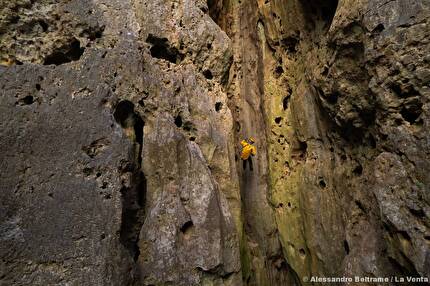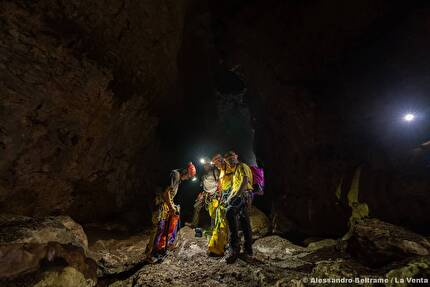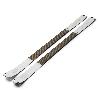La Venta beyond limits / Exploring the Qanaf Cave in Oman

 1 / 27
1 / 27 Alessandro Beltrame / La Venta
Alessandro Beltrame / La Venta
Southern Oman, Dhofar Province, Qanaf Cave: a large sinkhole opens at the end of a "uadi" (a canyon bed or gully where a non-perennial stream flows) draining a catchment area of over 10 square kilometres on the Jabal Samḥān plateau. A steep cliff at about 1000 m asl dominates the coast between the cities of Mirbat and Salalah.
Here, at the invitation of their French friend Philippe Audrà, a speleologist and researcher at the University of Nice, who has been studying the country's caves for years, the La Venta group has tried to overcome the environmental and human limits imposed by this cave so far.
The Quanaf Cave has already been the scene of several exploratory expeditions in recent decades: a Slovenian one in 1997, a British one in 2012 and two French ones in 2014 and 2022, which have pushed the exploration of this cave to a depth of more than 200 metres and a planimetric development of just over a kilometre. The current limit of exploration, of which there is no topographical or video-photographic documentation, is represented by an approximately 100 meter long lake leading to a shaft about 15 metres deep that overlooks a large gallery where no one has ever set foot. The probable resurgence of the Qanaf Cave is about 12 km away as the crow flies.
The aim of the 2024 expedition was to overcome this exploratory limit, facing the great environmental challenge that the cave holds in its depths. In fact, all reports from previous expeditions speak of serious breathing problems, with carbon dioxide levels of up to almost 4%. The 'uadis' are almost always dry, given the low rainfall, but on some occasions these can be very intense, with almost a decade-long frequency. On such occasions, sinkholes, such as Qanaf, collect huge volumes of water, filling up completely and collecting large quantities of organic materials carried by the water flow. The last such event was in 2018; on that occasion, the water not only filled the cave, but also flooded a large part of the plateau. The organic material dragged into the cave slowly decomposes, producing carbon dioxide and heat, thus creating an almost 'hellish' environment for humans, with CO2 concentration at unsustainable levels, oxygen deficiency, temperatures up to 29°C and relative humidity close to 100%. To complete the picture, reports from previous explorations also speak of large colonies of bats (still present), with the presence of guano and therefore a possible risk of contracting respiratory diseases, such as histoplasmosis, which is contracted by inhaling the spores of fungi that proliferate on large accumulations of organic material.
The initial challenge was therefore to find a technology to attempt safe exploration in such an extreme environment. We therefore came up with two possible technical solutions: the first, consisting of self-contained breathing apparatus for confined environments, with composite cylinders and facemasks, which could be recharged at a local diving centre, but were bulky and heavy, especially for a cave with difficult progression such as Qanaf Cave. These materials were provided to us by technical partners specialised in prevention and safety. The second was to experiment with the use of oxygen concentrators with medical nasal cannulae. On this first expedition, we only adopted the technology with oxigen concentrators, the latter protected with caving bags specially constructed for this purpose.
For the location of the base camp, we chose an area just above the uadi of Qanaf Cave, in a vast stony semi-desert area at about 1,000 metres altitude, frequented daily by herds of cattle and dromedaries. On-site logistics proved to be quite convenient, as there were settlements within easy reach. After setting up camp and the larder, the actual expedition began, with the first three days dedicated to equipping the cave with ropes and anchors, up to the large bat room. Here, given the enormous amount of guano present, we avoided the risk of contracting histoplasmosis with the constant use of FFP3 masks. With the help of gas detectors, we were able to record CO2 concentrations and temperature and humidity values throughout the cave, thus producing a detailed mapping. By doing so, we were able to attribute a different level of danger to the various areas of the cave in order to proceed inside it safely.
The cave develops with a first open shaft some fifty metres deep, followed by another twelve. From there, a series of galleries originate in which the percentage of CO2 progressively increases. Along the cavity we encounter numerous pools of stagnant water, large halls with large boulders to be climbed over, and a thirty-eight metre shaft, so wide that during the minutes suspended in the void our lights could not illuminate its walls; from above, only the pinpoint of light from our companions ahead of us showed us the way forward.
The entire cave is affected by very slippery areas due to the considerable amount of rotting organic material brought into the cave by the floods during the rainy season. In these areas during our progression we were often accompanied by the ominous sound of gas detector alarms, activated by the increasing CO2 levels.
At a depth of about 150 m, after more than a kilometre of cave, at the edge of the chamber below the thirty-eight metre shaft, we find the wreck of a large water tank of about fifteen cubic metres, indicated on the survey as 'Tank'. The tank was dragged all the way down there by the 2018 flood and forcibly wedged into a fracture, the only possible way forward, creating an uncomfortable bottleneck between metal and rock that makes it difficult to get through.
Having equipped the cave and carried out the first descents to transport the material, we dedicated ourselves to monitoring the air, finding that the percentages of CO2 present up to the bat chamber, one kilometre from the entrance, are in greater quantities than those reported on the original survey, as are temperature and humidity, with values of around 26°C and humidity up to 95%; limiting conditions for any human progression.
From the large bat chamber onwards, safe progression is only possible with oxygen concentrators. By means of them we reached the 10-metre shaft that overlooks the final lake. Below the shaft an invisible enemy bars the way; in fact, the CO2 values rise to 4.7%, the temperature to 29°C and the humidity to 98%. A deadly environment.
Beyond the lake, on sight, the cave continues to flood, but we decided not to continue because the oxygen concentrators, at the limit of their operational capacity, did not guarantee sufficient supply to cope with the crossing of the body of water, and above all the safe return. The symptoms felt in that hostile environment on a physiological level were those of difficulty breathing, strong pressure on the ribcage, a sensation of forced suction of air from the lungs and constriction of the same. We will return, this time with more suitable equipment; we are already studying new systems. The Qanaf cave promises great development and exploration, but going forward will require determination and the utmost caution.
Participants: Luca Imperio, Tullio Bernabei, Antonio De Vivo, Gaetano Boldrini, Francesco Lo Mastro, Enrico Giacomin, Alessandro Beltrame e Luca Marzioni.
Special thanks are due to the Dhofar Adventures association in Salalah, which supported the expedition by providing accommodation in Mirbat, technical cave- mountaineering equipment and a generator that made it possible to illuminate the camp at the grotat and to recharge the battery-powered equipment used inside the Qalaf cave.
Project partners:
Ferrino - Tents and outdoor equipment
Miles Beyond - Extreme locations, logistics and training Vigea - Virtual Geographic Agency
Icon - Industrial safety line
Conec Care - Oxygen concentrators
DE-OX Temc - Digital gas analysis
Draeger - CO2 detectors
Prait - Accident prevention training centre Prevent - Industrial safety and rescue
Primus Equipment- Stoves and field equipment Sony Italia - Consumer electronics
Spasciani - Safety technology
T2.0 - Mountain equipment
Tiberino Outfood - Freeze-dried foods
Luca Imperio e Antonio De Vivo / La Venta



 Copia link
Copia link



















 See all photos
See all photos























